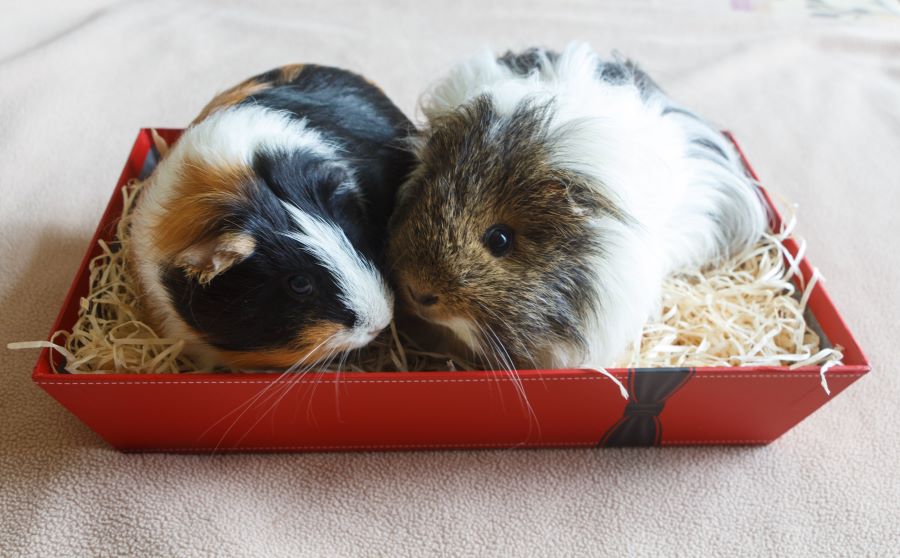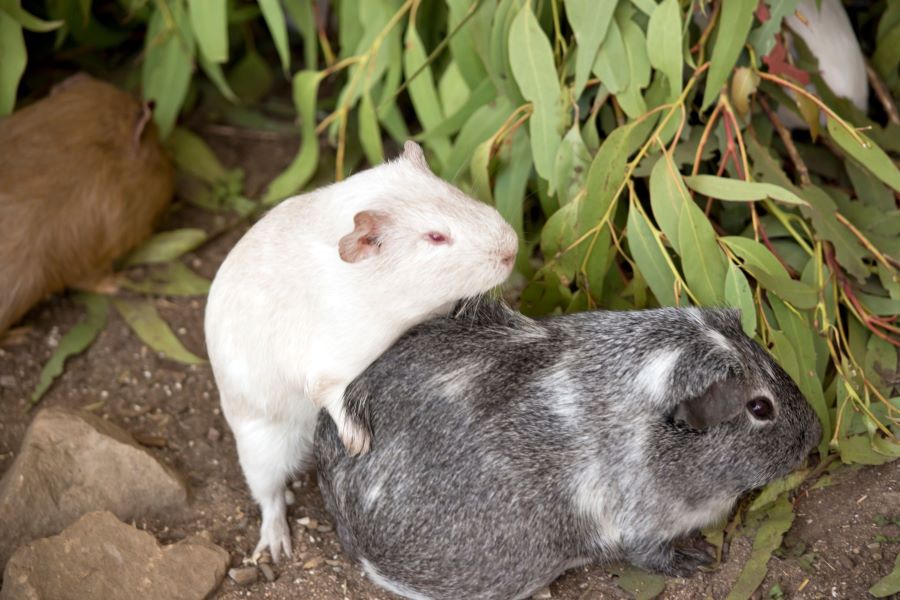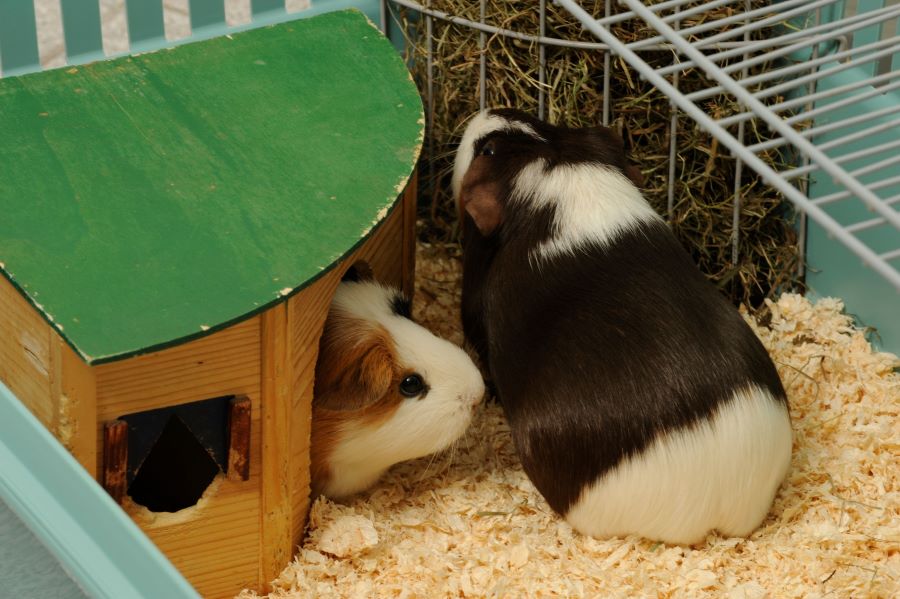Some of the posts on Mercury Pets contain affiliate links to products. That means if you click on that link and then make a purchase, we receive a percentage of the sale. We only recommend products we’ve used and support, and there’s no additional cost to you — the money goes right back into making this site the best it can be! Thanks for reading.

If you own a male and female guinea pig, you may be wondering how to know if they’re interested in mating. Thankfully, guinea pigs have well-defined mating rituals that help owners know exactly what’s up with their pets’ sudden changes in behavior.
When ready to mate, both male and female guinea pigs strut and rumble throughout their enclosure. A male may chase the females in his cage around, attempt to mount them, or even stand up on his hind legs to assert his dominance. Female guinea pigs mirror some of these actions.
This article provides an in-depth description of the ten most prominent signs exhibited by guinea pigs before and during mating and provides interesting facts about the process in general.
1. Mating Calls
Guinea pigs are surprisingly good at communicating with each other due to their excellent hearing and wide range of vocal abilities. Guinea pig mating calls are distinctive and very easy to notice, and both males and females make them at different stages during mating.
The most common vocalization pre-mating starts as a deep rumble. A rumble sounds like a low-pitched purr and is often called motor-boarding for a good reason.
A male guinea pig interested in mating with an accessible female usually begins his rumbling while pacing the cage, wiggling his hips from side to side. This is done to attract his potential mate. A metaphoric love ballad, if you will.
If a female is in heat, and the male isn’t paying her any attention, she too will begin to rumble to garner his attention.
While rumbling is reserved exclusively for mating purposes, you may sometimes mistake the sound for purring. However, if the sound is accompanied by strutting, you can be sure it is a rumble.
Here is a video of guinea pig mating calls in action:
2. The Guinea Pig Mating Dance
The guinea pig mating dance is a show of agility, coordination, and flair aimed at impressing any females in the vicinity.
Also known as a rumble strut, wherein the guinea pig does his little dance while loudly rumbling, the action also serves to assert dominance and intimidate other males who could get in the way of his mating activities.
Females rumble strut too; however, they do this exclusively to show their superiority and essentially tell all the other females, “I’m the boss!”
A strut, especially when involved in the courting process, is an amusing dance performed by a guinea pig who begins to shake, nearly vibrate, and shift its weight from one foot to the other while moving around the cage.
Some guinea pigs will sway their rumps around as they strut, making the whole occurrence quite funny to humans, although it is seen as very macho and intimidating by other guinea pigs.
If a male begins his dance, and the female makes a sound similar to grinding teeth, known as chattering, it means she is most definitely not interested, and there will be consequences if he tries to mate with her.
3. Male Chasing Female Guinea Pigs Around the Cage
Guinea pigs can sometimes be very childish, especially when they’re trying to figure out who’s the boss and who is available for mating. One of the signs your male guinea pig may be trying to impregnate a female is if he is regularly chasing them around their cage.
Like some twisted game of chase, the male will continue sprinting after his chosen female and may mount her when he catches up.
Female guinea pigs also exhibit chasing tendencies, especially when trying to establish the enclosure hierarchy. If your male guinea pig begins to chase the other males he is caged with, don’t worry. Much like the females, he may simply be trying to elevate his status.
4. Males Sniff and Lick Females
The next step in guinea pig foreplay is the initiation of contact. A male guinea pig searching for a mate will often sidle up to the female and begin to lick her or sniff her rump.
Guinea pigs of all sexes may do this to detect pheromones or collect information on their cage mates.
However, this may also be a pretty obvious sign that your male guinea pig is about to attempt procreation. A male guinea pig will sniff a sow to establish whether or not she is in heat and ready to be mated with.
5. Nuzzling
A further step in the anogenital investigation of your guinea pigs may be nuzzling, either of the genitals or the body in general.
Other than providing a male with closer access to detect more smells, nuzzling close to each others’ bodies may be a sign that your guinea pigs like each other and are beginning to bond. If you and your pet share an especially strong bond, you may even find they try to nuzzle or cuddle with you as a sign of affection.
Bonded pairs of guinea pigs often spend time near each other while nuzzling or grooming to deepen their friendship.
Nuzzling during mating may directly precede mounting or be followed by a final display of attraction where the male guinea pig suddenly pulls himself up to stand upright.

6. Males Standing Upright
As behavior typically exhibited before fighting, a male guinea pig standing upright may frighten or worry its owner.
If a male guinea pig has spotted a suitable and willing female, he may get up on his hind legs to give one last show of dominance while also surveying his surrounding.
If your guinea pig has gone through all the previous steps in the mating ritual and suddenly decides to stand up, you can be assured the deed is about to be done.
7. Males Mount Females
Mounting occurs between guinea pigs of the same and opposite sex. It can be a way for them to mark their territory, assert dominance, or show the rest of their companions who’s in charge. This could be accompanied by urine spraying, which is entirely normal and should not cause concern.
However, during mating, mounting is usually initiated by the male mere seconds after nuzzling or displaying his dominance.
8. Female Will Squeal Loudly
Once the business has commenced, the female guinea pig may squeal loudly. The actual act of mating only lasts a few seconds, so the sometimes distressing sound should die down very quickly.
Outside of mating, squealing is usually a distress signal indicating something is hurting or annoying your guinea pig. However, during mating, the sound is quite natural and should not be a cause for alarm.
9. If The Sow Isn’t in Heat, She May Bite or Urinate on the Male
Despite the showy display before mating, a male guinea pig may not realize until he tries to mount that the female is not in heat and not in the mood for his advances.
If he managed to blunder past the chattering teeth and obvious show of disinterest, a male mounting an unsuspecting or unwilling female may be met with a rather nasty welcome.
Female guinea pigs are very picky over who they choose to mate with, unlike males. If, for any reason, they do not want to have relations with the interested male, they may bite him if he tries to approach them.
Another method used to deter a male is urine spraying, which is as gross as it sounds — and equally effective.
Urine spraying is their way of saying “back off” or “stay away.”
10. Sow Signs of Being in Heat
A female guinea pig’s cycle lasts 16 days and provides an average eight-hour window for mating.
Signs that a sow may be in heat include:
Increased Activity
A sow in heat may become more active as she searches for a mate. This could manifest in her pacing up and down her cage or chasing other female guinea pigs in her enclosure. Once mating has occurred, however, this behavior stops for the rest of the possible pregnancy.
Swollen Vulva
Most female guinea pigs may exhibit a swollen vulva as part of their overall enlarged genitals when in heat. Mistaking your guinea pig’s sex is more common than you may expect, and the swollen appearance of your assumed female pet could be its testicles.
Chasing and Mounting Companions
If your sow is housed with other female guinea pigs, you may notice her chasing and mounting her friends while in heat. There is no harm in this, as the activity is simply due to the increase in certain hormones around the time she is most likely to be impregnated.
Arched Back and Pushed Out Tushy
A sure sign your sow is in heat is if she goes about her day with her back arched and her bum pushed up. Quite like some girls do to make their figures more enticing, female guinea pigs have learned the art of the twerk.
They spend their time with their booties out, shaking and strutting in hopes of attracting a mate.
Low-Pitched Squeaking
Think of it as the female guinea pig’s mating call. Low-pitched squeaking from a sow may indicate she is in heat and attempting to attract a mate. It differs greatly from rumbling and is usually done more quietly too.
It almost sounds as if she’s talking to herself.
Important Facts to Know About Guinea Pig Mating and Reproduction
Understanding how guinea pig mating works, and the risks involved, is critical if you are thinking of breeding your pets. Some of the most important facts to be aware of include:
- Guinea pigs reach sexual maturity at around one month old.
- A female guinea pig cannot safely give birth after she reaches 10 months old due to the fusion of her pubic bones around this age or earlier, which could create serious complications.
- A female guinea pig is only fertile for between six and eleven hours each cycle. [Source]
- A sow usually carries her litter for 59-72 days. [Source]
- Each pregnancy carries around three piglets, although more is not uncommon.
- Due to this, breeding with a female guinea pig older than five or six months could be extremely dangerous.
- If a sow is impregnated after this window, a C-section will be necessary to safely remove the babies once they are mature enough.
- A female guinea pig is able to mate again as little as 15 – 36 hours after giving birth.
- Contrary to popular belief, the male guinea pig, or boar, will not eat or harm the babies once they are born. Removing him from the cage is only recommended as he may try to mate with the female again soon after their birth.
- Baby guinea pigs are usually born at night and come into the world with teeth and fur at the ready.
- Male guinea pigs can be neutered and subsequently housed with a female companion who may end up bonding with them for life.
- Baby guinea pigs are ready to start eating adult food as soon as two days after being born.
Conclusion
Guinea pig mating is not as straightforward as many new owners expect. Their rituals, vocalizations, and dances are important to recognize if you want to ensure the well-being of your sow by preventing late or unwanted pregnancies.
However, if you decide to breed your guinea pigs, the process can be fascinating to observe and provide a rewarding outcome for both you and your pets.



